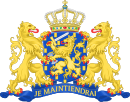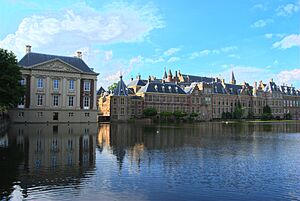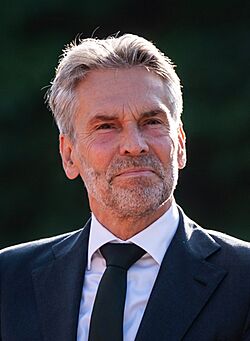Prime Minister of the Netherlands facts for kids
Quick facts for kids Prime Minister of the Netherlands |
|
|---|---|

|
|
| Ministry of General Affairs | |
| Member of |
|
| Residence | Catshuis, The Hague |
| Seat | Torentje, The Hague |
| Appointer | Monarch of the Netherlands |
| Term length | Four years, renewable |
| Inaugural holder | Gerrit Schimmelpenninck |
| Formation | 25 March 1848 |
| Deputy | Deputy Prime Minister |
| Salary | €205,991 (As of 2025[update]) |
The prime minister of the Netherlands (Dutch: Minister-president van Nederland) is the main leader of the Dutch government. Even though the King or Queen is officially the head of government, the prime minister does most of the work. They lead the Council of Ministers, which is like the cabinet, and help make sure all government policies work together.
The prime minister also represents the Netherlands at important meetings like the European Council. Many people have held this job. The current prime minister, Dick Schoof, started on July 2, 2024.
Contents
How the Prime Minister's Role Developed
Over time, the job of prime minister became the official role of the government leader. This person is usually the political leader of the biggest party. The role became important in 1848. That year, the Constitution of the Netherlands changed. It made ministers responsible to the parliament, not just the King.
Before 1901, the job of leading the Council of Ministers rotated among different ministers. From 1901 to 1945, it still rotated, but important politicians could hold the position for four years.
In 1937, a special office called the Ministry of General Affairs was created. This office was linked to the prime minister. Most prime ministers are leaders of the biggest party in the government. However, Barend Biesheuvel (1971–1974) was not. Also, Dick Schoof (2024–present) is an independent politician. This means he does not belong to a specific political party. He was chosen to lead a group of right-wing parties.
In 1983, the role of prime minister was officially written into the Dutch constitution. Since then, the formal title has been "minister-president." In English-speaking countries, this is almost always translated as "prime minister."
The prime minister's role became even stronger because of the European Council. In 2006, new rules allowed the prime minister to add any topic to the Council of Ministers' agenda. They no longer had to wait for another minister to suggest it.
What the Prime Minister Does
The prime minister is the most important political figure in the Netherlands. They hold the highest office in practice. However, the Dutch prime minister is not as powerful as, for example, the British prime minister or the German chancellor. This is because, in the past, all Dutch ministers were responsible to the monarch. Ministers took turns being prime minister and had little control over others.
The prime minister's role grew when ministers became responsible to the parliament. The job then usually went to the leader of the biggest political party in the House of Representatives. Still, the prime minister is often called primus inter pares. This Latin phrase means "first among equals." It shows they are the leader, but also work closely with other ministers.

After a review in 1983, the prime minister's role was officially added to the Dutch Constitution. The Constitution says the government includes the King and the ministers. It also states that the prime minister leads the Council of Ministers (article 45). The King appoints the prime minister (article 43). The prime minister must also sign the King's decree for their own appointment and for other ministers (article 48). The King no longer attends the Council of Ministers meetings.
The prime minister leads the weekly meetings of the Council of Ministers. They can also decide what topics will be discussed. The prime minister is also the Minister of General Affairs (Minister van Algemene Zaken). This role is important for making sure government policies are coordinated. They are also in charge of the Netherlands Government Information Service.
The prime minister is also responsible for matters related to the royal family. They have a weekly meeting with the King to discuss government policy. The prime minister is also seen as the "face" of the government to the public. After cabinet meetings on Friday, the prime minister holds a press conference. They talk about the cabinet's decisions and current events. The prime minister also works on international matters. They attend the European Council every six months and meet with leaders from other countries.
Since the 1980s, the prime minister's office has been in a small octagonal tower. It is called "The Little Tower" (Torentje) and is located in the Binnenhof in The Hague. The official residence, used for special events, is the Catshuis. The last prime minister to live there was Dries van Agt.
Prime ministers are almost always leaders of their political party. They are usually elected as members of the House of Representatives. However, they must give up their seat in parliament while they are ministers. This is because Dutch ministers are not allowed to be members of parliament at the same time.
How a Prime Minister is Chosen
The Dutch election system makes it very hard for one party to win enough votes to have a majority. No party has done this since 1900. Because of this, Dutch governments are always formed by a group of two or more parties working together. This is called a coalition.
After an election, the House of Representatives chooses a "scout." This person helps figure out how to understand the election results. Then, the House appoints an informateur. This person checks which parties might work well together and leads talks between them. If these talks are successful, the House then appoints a formateur. This person finishes the agreements between the parties that will form the new government. The formateur is almost always the leader of the largest party in the new group. This means they are usually the person who will become prime minister.
Deputy Prime Ministers
The King also appoints deputy prime ministers. Usually, each smaller party in the government coalition gets one deputy prime minister. They are ranked by the size of their party. The highest-ranking deputy leads the cabinet meeting when the prime minister is not there. In the current Schoof cabinet, Fleur Agema is the first deputy prime minister. The other deputies are Sophie Hermans, Eddy van Hijum, and Mona Keijzer. If the prime minister and all deputies are away, the oldest member of the cabinet leads the meeting.
Prime Minister of the Kingdom
The prime minister is also the leader of the Council of Ministers for the entire Kingdom of the Netherlands. This means they also deal with matters for Aruba, Curaçao, and Sint Maarten. These are other countries within the Kingdom. Aruba, Curaçao, and Sint Maarten also have their own prime ministers. These are Evelyn Wever-Croes (Aruba), Gilmar Pisas (Curaçao), and Luc Mercelina (Sint Maarten). The Council of Ministers of the Kingdom also includes special ministers from these other countries.
See also
 In Spanish: Primer ministro de los Países Bajos para niños
In Spanish: Primer ministro de los Países Bajos para niños
- List of prime ministers of the Netherlands
- Historical rankings of prime ministers of the Netherlands
- Religious affiliations of prime ministers of the Netherlands


